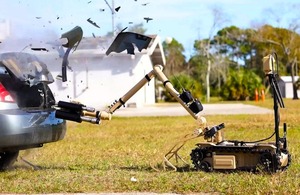New bomb disposal robots for the British Army
New high-tech bomb disposal robots will provide greater protection for soldiers and the public in a new deal for the British Army announced today (10 May).

Photo courtesy of L3Harris Technologies Image of a bomb disposal robot handling an explosive device in a car boot
- High-tech robots will protect soldiers and the public from variety of threats including explosives and hazardous materials.
- Can operate in narrow spaces, tough terrain, and climb stairs.
- £21m investment will see robots delivered by end of the year.
New high-tech bomb disposal robots will provide greater protection for soldiers and the public in a new deal for the British Army announced today (10 May).
50 of the T4 bomb disposal robots will be able to be used in situations of bomb and hazardous material disposal, helping the explosives team who attend thousands of call outs every year, all over the country. This will greatly reduce the risk to service personnel and the public when neutralising bomb and chemical threats.
A £21 million contract with L3 Harris Technologies – based in Tewkesbury - will deliver with the first T4 units before the end of 2024.
Adept at navigating narrow urban spaces, with its tough all terrain treads and adjustable manipulation arm, the T4 can operate in narrow aisles of planes, trains and buses and can even climb stairs.
Advanced controls, high-definition cameras and lightning-fast datalinks will enable the operator of the T4 to perform complex tasks like unzipping bags and opening glove boxes from a safe distance.
We are ensuring that our Armed Forces have the best kit available, and we have recently announced plans to spend 2.5% of GDP on defence by 2030 – meaning an additional £75 billion spent over the next six years
Minister for Defence Procurement, James Cartlidge said:
Procuring this high tech robot means that we can provide our forces with the tools they need to safely handle a range explosive threats.
Rapidly delivering uncrewed systems, like the T4, that ensure our armed forces can safely face future threats is a key part of our Drone Defence Strategy.
Weighing in at just over 100kg, the T4s are significantly smaller and nimbler than their bigger brother – the 300kg T7 UGV – and will be used as the rapid response system for emergency situations as its compact size means it can be transported in a standard 4x4 vehicle.
However, both models use ‘advanced haptic feedback’ which allow operators to ‘feel’ their way through the intricate process of disarming devices from a safe distance, reducing the risk to life of the explosive ordnance operators.
The systems, which underwent rigorous testing, have been contracted by Defence Equipment and Support (DE&S), the procurement arm of the UK MOD and include an initial three years of in-service maintenance and repair support.
Major General Lizzie Faithfull-Davies, Director Land Equipment at DE&S, said:
I’m incredibly proud of the project team at DE&S, who have worked with their industry partner to harness available cutting-edge technology and have identified a critical capability that can respond to hostile explosive threats and help in keeping the wider general public safe.
The T4’s will enter service with the 29 EOD & Search Group and the Diving Threat and Exploitation Group, Royal Gibraltar Regiment (RG) and Cyprus Operational Support Unit (COSU).
Ed Zoiss, President, Space and Airborne Systems, L3Harris, said:
The T4 EOD robots are the world’s most capable robot for operations in crowded and difficult environments like subways, airports and even hospitals.
These highly advanced, durable robots provide best-in-class mobility and uncompromised performance to protect human lives.
We’re honoured to continue working with the U.K. Ministry of Defence as they provide this technology to the British Army.
Updates to this page
-
50 Robots will be delivered in total, with deliveries starting at the end of year. Not all 50 to be delivered by the end of the year.
-
First published.